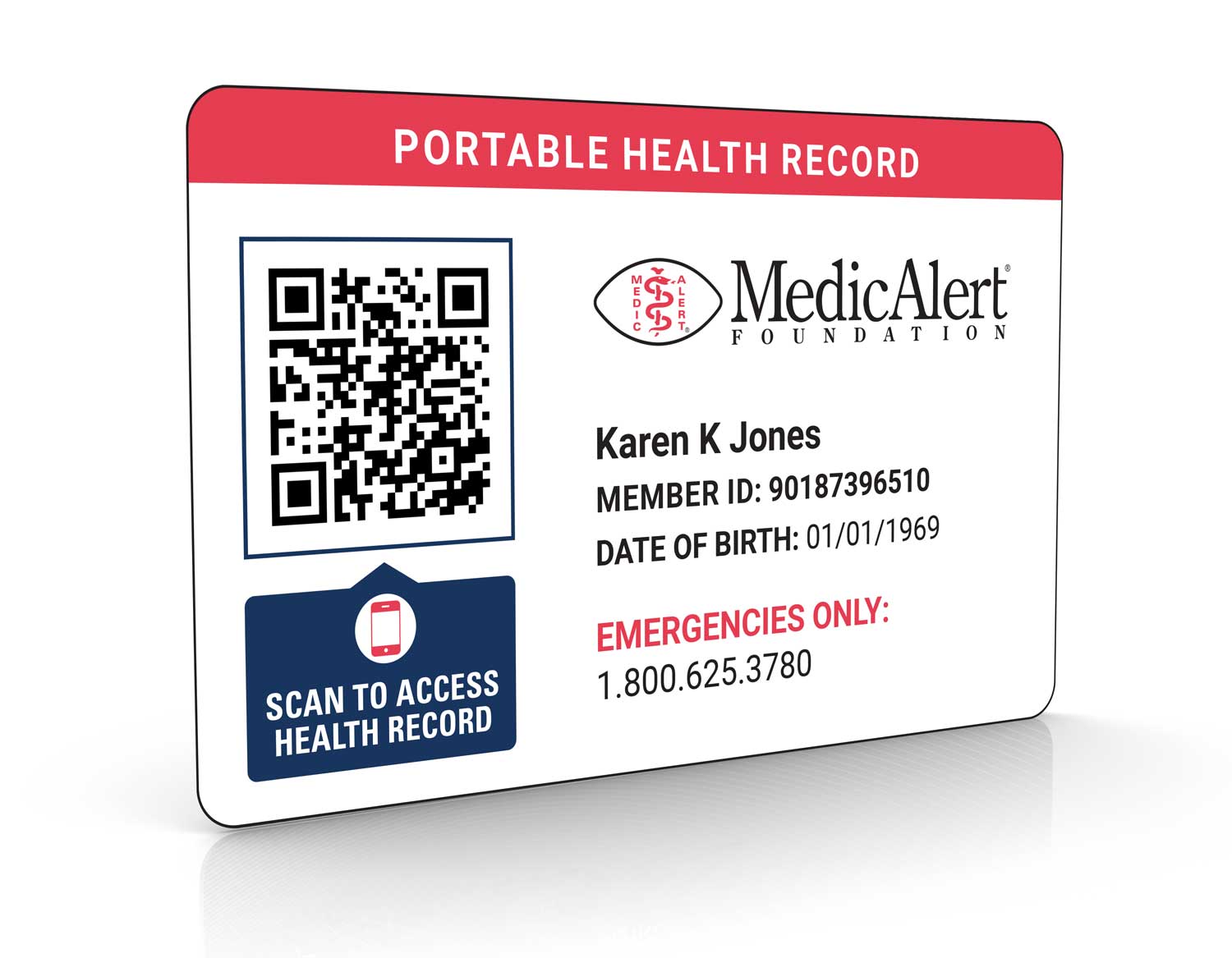Sickle cell is an uncommon disease and many healthcare providers may not be aware of national and international guidelines regarding acute presentations. A medical ID facilitates knowledge transfer and aids communications with emergency services.
American Society of Hematology

Medical IDs for Sickle Cell Disease
The confidence to live with sickle cell disease
Sickle cell disease (SCD) is a life-long condition that can cause life-threatening complications. But with the right care, people with SCD can live full lives and enjoy most of the activities that other people do.
Sickle cell disease has several types, and often presents differently from person to person. One of the hallmarks of sickle cell are painful episodes called sickle cell crises, which can be very severe and last up to a week.
Pain is the leading cause of emergencies for people living with sickle cell, resulting in ER visits and often hospitalization. If emergency personnel are not aware of your SCD, they may not understand the pain crisis or provide appropriate treatment for your pain.
That’s why MedicAlert is vital for those living with sickle cell disease – to communicate to others about your condition and help you get the right treatment in an emergency.
A MedicAlert ID will immediately signal to first responders that you have sickle cell, and with a MedicAlert protection plan, you can store your complete health records, contacts for your specialists, and treatment plans for sickle cell crises or other complications. MedicAlert is not just a sickle cell bracelet – it’s peace of mind for people living with sickle cell.
How MedicAlert protects those living with sickle cell disease
One thing you shouldn’t worry about is what could happen if there’s an emergency. MedicAlert’s protection plans offer benefits that extend beyond the ID, providing safety and peace of mind for those living with sickle cell disease.

24/7 Emergency Response
Our team provides first responders the information they need to provide fast, accurate care.

Digital Health Profile
All your vital information, all in one place for you and your caregiver.

Emergency Contact Notification
In an emergency, we connect families so that no one is alone in a crisis.

Patient Instructions
Share the information that’s important to your care, such as use of rescue medications or contraindication for tests like MRIs.
Pair a medical ID for sickle cell disease with the protection plan that’s right for you.
What is sickle cell anemia?
Sickle cell disease is one condition of a group of inherited blood disorders known as sickle cell disease or SCD. It happens when hemoglobin — a protein found in blood cells — becomes defective, affecting the integrity of red blood cells.
Healthy red blood cells are smooth and round, with a slightly indented center, like doughnuts without a hole. This allows them to move easily through blood vessels and carry oxygen throughout the body. But in sickle cell anemia, red blood cells are shaped like sickles or crescent moon.
With time, these abnormal red blood cells also become hard and sticky, making them more likely to stick to small blood vessels and clog blood flow, which can slow or obstruct circulation and oxygen to other parts of the body. This can lead to severe pain, infections, organ damage, and stroke.
Sickle cells also have a significantly shorter lifespan than regular red blood cells. A healthy red blood cell with normal hemoglobin can live up to 120 days, whereas sickle cells only last 10 to 20 days. As a result, the body isn’t able to replace the lost cells fast enough, leading to a chronic shortage of red blood cells (anemia).
Who is affected by sickle cell disease?
Sickle cell disease is a rare genetic blood disorder affecting 70,000 to 100,000 people in the United States. It mainly occurs in African Americans and those with Hispanic and Caribbean ancestry. Although globally, the disease is also found among people of Middle Eastern, Mediterranean, and southern Asian descent.
How is sickle cell disease diagnosed?
In the United States, all states are required to test newborns, regardless of their ethnic background, for the sickle cell gene as part of routine screening. This is because early diagnosis can significantly reduce the risk for future complications.
Sickle cell disease can also be diagnosed before birth by taking a sample of the liquid in the mother’s womb (amniotic fluid) if one or both parents have sickle cell disease or the sickle cell trait. In adults, a blood test can check for the defective hemoglobin that causes abnormally-shaped red blood cells.
How is sickle cell disease treated?
Treatment of sickle cell disease is usually aimed at reducing pain crises and preventing complications like organ damage and stroke. To date, the only known cure are stem cell transplantations, although they remain complex and risky procedures with serious side effects, so they are usually limited to children with severe sickle cell anemia.
Treatments that can help manage symptoms, prevent complications, and prolong life include:
- Pain relievers for acute or chronic pain
- Antibiotics to prevent or manage infections
- Childhood immunizations and annual flu shots
- Hydroxyurea, a medication that makes sickle cells less sticky
- Blood transfusions
- Drinking plenty of water and eating a healthy diet
What to engrave on MedicAlert medical IDs for sickle cell disease:
MedicAlert offers free custom engraving on all our sickle cell disease braclets and medical ID products. Engravings on medical IDs for sickle cell anemia should include any critical medical information that can protect and save your life if you are in an accident or have a medical emergency, for example:
- Medical conditions
- Medications
- Allergies
- Implanted devices
- Any medical information that needs to be communicated to first responders

Sample engraving. Consult our team if you need help engraving your medical ID for sickle cell disease.
What are the symptoms and complications of sickle cell disease?
One of the hallmark symptoms of sickle cell disease is pain, which happens when oxygenated blood can’t get to different parts of the body. This is known as a pain crisis or sickle cell crisis and can occur anywhere in the body, including the arms, legs, joints, or back. These episodes of pain range from mild to severe and may last from a few hours to several weeks.
Other signs and symptoms of sickle cell anemia include:
- Anemia: sickle cell anemia depletes the body’s hemoglobin reserves, which causes anemia. Severe anemia causes fatigue, dizziness, shortness of breath, and pale skin.
- Frequent infections: sickle cells can damage your spleen, an organ that acts as a blood filter. This can leave you more vulnerable to life-threatening infections, like pneumonia.
- Swelling: sickle cells can block blood flow to your limbs, causing swelling of the hands and/or feet.
- Jaundice or yellowing of the skin: people with sickle cell anemia tend to have pale or yellowish skin due to bilirubin buildups. The condition can also cause yellowing of the whites of the eyes (icterus).
- Vision problems: sickle cells can clog the tiny blood vessels that supply the eyes with blood, damaging the retina and leading to vision problems.
People living with sickle cell anemia may also have a number of complications that require immediate medical intervention, such as:
- Blood clots
- Acute chest syndrome (a type of lung infection)
- Organ damage
- Blindness
- Leg ulcers
- Sepsis (severe response to infection)
- Stroke
- Gallstones
- Priapism (painful, long-lasting erections caused by blocked blood vessels in the penis)
- Pregnancy complications
How medical IDs for sickle cell disease combined with MedicAlert Membership provide protection
Sickle cell disease is a life-long condition that can cause life-threatening complications, but it’s also possible to achieve a normal, healthy life with minimal disability.
If you or your child has sickle cell disease, wearing a medical ID for sickle cell disease could save your life during an emergency. Sickle cell jewelry can alert first responders and healthcare providers of your condition in times of need and provides all the necessary information to help them administer the correct treatment in situations when you’re unable to communicate your needs.
Every person with sickle cell disease is different, so it’s recommended that you choose a personalized medical ID for sickle cell disease that can hold your or your child’s unique medical information. Some details you may want to consider adding to your sickle cell jewelry includes: Your name; sickle cell status and other medical conditions, if any; allergies; specific medications; emergency contact number (including ICE contact and doctor’s contact information.
- We’re your voice: If you can’t speak for yourself due to an accident or other medical emergency, your ID will speak for you – informing others about your sickle cell disease and any medications you’re taking.
- 24/7 emergency protection: In an emergency, the MedicAlert team will relay all of your critical medical information to first responders, no matter where or when your emergency happens.
- Always connected: You should never be alone in an emergency. That’s why MedicAlert will reach out to your designated contacts if you are unable to do so.
- Live with peace of mind and confidence: MedicAlert will be there for you every step of the way. You’ll have the confidence and freedom to live your life with sickle cell disease.
DISCLAIMER: THIS WEBSITE DOES NOT PROVIDE MEDICAL ADVICE. The information in this article is presented for educational purposes only and is not intended as a substitute for professional medical advice, diagnosis and treatment. Always seek the advice of a physician or other qualified healthcare provider for any questions you may have regarding a medical condition or treatment.







